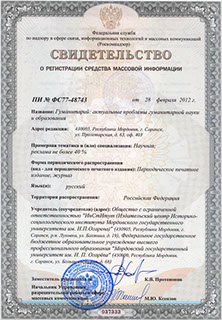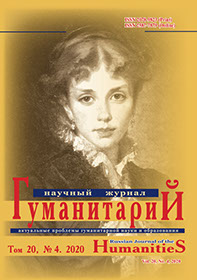ГуманитариЙ актуальные проблемы гуманитарной науки и образования
Russian Journal of the Humanities
ISSN 2078-9823 (Print)
ISSN 2587-7879 (Online)
Navigation
ISSN 2078-9823 (Print), ISSN 2587-7879 (Online)
DOI: 10.15507/2078-9823.052.020.202004.402-414
УДК 338.483
Larisa A. Zaytseva
Ogarev Mordovia State University (Saransk, Russia),
e-mail: sama_la@mail.ru
Public Opinion Leaders as a Means Of Representing the Image of the Republic of Mordovia
Introduction. The social function of a public opinion leader is to draw public attention to the most important issues of public life, participate in public discussions, explain and influence public opinion. Political communication is implemented in two dimensions – pragmatic and symbolic, which have very close relationships. The symbolic dimension develops and promotes ideas about society that create, maintain, or destroy political identity. For external target groups of image-making (political and business elites, decision-makers at the federal level, investors, highly qualified migrants, partially residents of other regions), significant repeaters of information about the region are representatives of state authorities and management, leaders of political parties and socio-political movements, bright representatives of the political opposition, etc. Materials and Methods. The research methodology was based on the method of cognitive mapping, which allowed analyzing and visualizing information transmitted by public opinion leaders about the regional space, determining the specifics of the perception of the Republic in the external power environment, and a historical and evolutionary approach that made it possible to trace the evolution of content. Time period of the study: 2012–2019. The study traced a series of judgments, stable expressions used by political and public figures about Mordovia, its potential, development prospects, and its leadership. Results and Discussion. Public opinion leaders (political and business elite, party figures, opposition, etc.) are significant repeaters of information about the region. Political communication is implemented in two main dimensions – pragmatic and symbolic, where the latter involves not rational understanding, but the suggestion of stable meanings. Symbolic politics has always been used by the authorities, especially in times of crisis, so the opinions conveyed by person-images become the basis of symbolic capital that promotes ideas about society (territory), creates, supports or destroys political identity. The external image of the Republic of Mordovia, which is formed on the basis of broadcast opinions, is contradictory. During the study period, we can note some evolution of the image of the Republic, broadcast by the leaders of public opinion. Attention to the region is noticeably increasing due to significant events of various scales. The high authority of the former leadership and loyal “electoral behavior” of the region contributed to the creation and broadcast of a positive image from the federal government and was a reason for criticism from opposition leaders. The celebration of the Millennium of unity of the Mordovian people with the peoples of the Russian state in 2012 was perceived positively by the majority of public opinion leaders and was actively broadcast in the media. The inclusion of Saransk among the host cities of the world football championship was received ambiguously: from a positive assessment to skeptical doubts about the correctness of such a choice. The legacy of the championship was not only the modernized infrastructure, but also the aggravated socio-economic problems of the region, which could not but affect its external image. Discussion and Conclusions. Thus, the positive image of the “territory of innovation”, “dynamically developing region with high-quality agricultural products” and “region of spiritual revival” coexists with the image of the territory of “total falsification”. The nature of the broadcast opinions is closely related to the peculiarities of the political situation and the official/oppositional position of the leader of public opinion in the discourse space.
Keywords: Republic of Mordovia, region, territory image, symbolic communication, person-image, public opinion leaders, political elite, opposition.
Acknowledgements: The research is executed with assistance of the Russian Federal Property Fund and the Government of Republic of Mordovia, the project “Modern Region in Focus of the political imagology (on the example of the Republic of Mordovia)”, project No. 18-411-130012 r_a.
For citation: Zaytseva L. A. Public opinion leaders as a means of representing the image of the Republic of Mordovia. Gumanitarian : aktual’nye problemy gumanitarnoi nauki i obrazovaniia = Russian Journal of the Humanities. 2020; 20(4): 402-414 (In Russ.). DOI: 10.15507/2078-9823.052.020.202004.402-414.

© Ogarev Mordovia State University. History and Sociology Institute, 2017
68, Of. 411, Bolshevistskaya St., 430005, The editorial office of the scholarly journal «Russian Journal of the Humanities»
Tel.: (8342) 24-25-90; 27-07-11, Fax: (8342) 24-25-90, E-mail: jurnal-econom-hist@isi.mrsu.ru
Designed by A. Napalkov, Email: napalkov@isi.mrsu.ru

